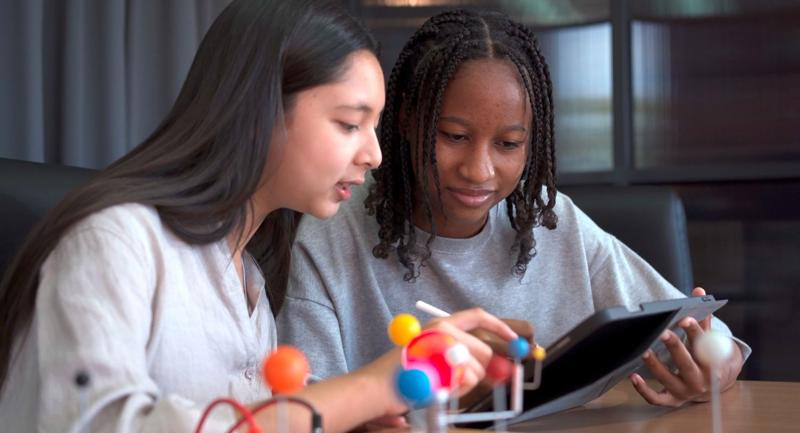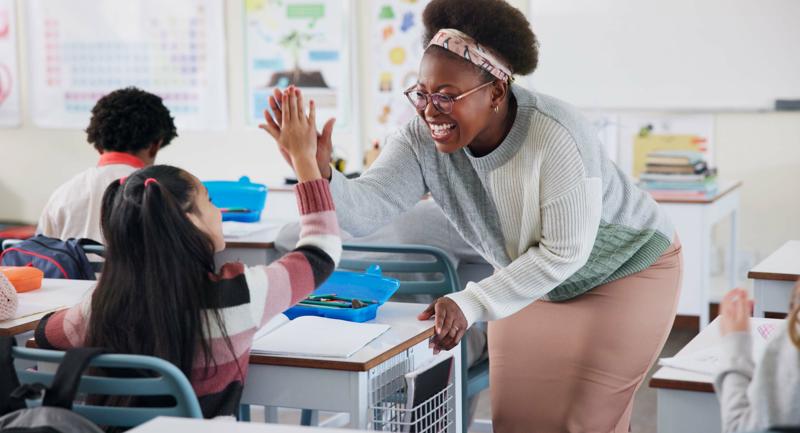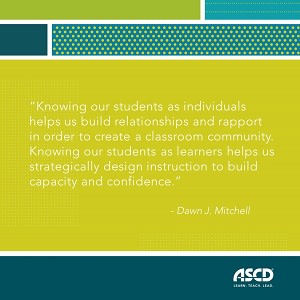What can you do to prepare your students, before they graduate, to become active citizens, employers, employees, and caretakers of our planet? The tools you provide in your classrooms and schools now can equip them with the skill sets they need to take on challenges and opportunities later.
Here are six ways you can prepare students for the “real world” by honing their executive functioning skills. As a neurologist and neuroscience researcher, I’ve translated the primary science research into strategies that correlate with my interpretations.
1. Provide Opportunities to Collaborate
Students need an evolving set of skills to collaborate with others and find creative solutions to global problems. The experiences you provide in the classroom can strengthen their prefrontal cortex executive function networks, which play a central role in influencing attention, prospective memory, cognitive flexibility, and impulse control.
Specifically, collaboration among students can activate the neuroplastic response that promotes this neural network growth. Try grouping students in small groups according to their strengths and interests. Students often have less fear participating in small groups (as opposed to larger groups), and having an expertise or interest that the group shares can increase their comfort.
2. Teach How to Evaluate Information Accurately
In today’s fast news culture, students are bombarded with information that may not be fully accurate or complete. They need to know how to assess the veracity/bias and potential uses of information. Guide them to build their executive functions of critical analysis. When students boost these needed executive functions, they are more prepared to find, analyze, and use the information available now and in the future.
Having students decide which advertisements and websites that they think are valid, for example, can be a good starting point. They can then consider what characteristics led them to determine this validity and discuss it in small groups to begin building their own skills of analyzing validity. As the year goes on, give them opportunities to revisit their list of characteristics and revise it as they evaluate subsequent sources.
3. Ensure Enduring Understanding and Conceptual Thinking
As Einstein said, "If you can't explain it simply, you don't understand it." When students evaluate information and define the most essential ideas, they build judgment skills and concept understanding.
Have students extract a valuable big idea—the essence of a lecture, discussion, or reading assignment—and summarize it concisely. They can share responses on a class website using blogs, Instagram, Twitter, or a photo/sketch with a description to represent the concept. Using these modalities, they are identifying the big ideas and communicating them concisely.
4. Transfer Learning to Long-Term Memory
New "learning" does not become permanent in our memory unless there is repeated stimulation of new memory circuits in the brain’s pathways. This is the "practice makes permanent" aspect of neuroplasticity where the most stimulated neural networks develop more dendrites, synapses, and thicker myelin for more efficient information transmission. These stronger networks are less susceptible to pruning and become long-term memory holders and executive function skill sets.
Students need to use executive functioning skills as they learn, practice, plan, and analyze. When you provide students with opportunities embedded in the curriculum to activate these neural circuits repeatedly and in different, personally meaningful ways, the executive functions they build will be available for “transfer” from school learning to real life situations, decisions, and collaborations. Try, for example, having students use a rubric that will be used to grade them and show what percentage of the grade comes from each item on the rubric. They then use that to evaluate how much time they should dedicate to each and prioritize when to do each.
New "learning" does not become permanent in our memory unless there is repeated stimulation of new memory circuits in the brain’s pathways.
Judy Willis
5. Delay Immediate Gratification
One of the most essential executive functions developing in students' prefrontal cortexes is the ability to delay immediate gratification and to apply effort toward long-term goals. The executive functions (e.g., thoughtful decision making, judgment, critical analysis, organizing, prioritizing, cognitive flexibility) cannot spring up de novo. As students’ judgment, prioritization, and goal pursuit neural networks are undergoing their greatest rate of maturation between ages 5 and 25, students need experiences that correlate effort toward progress. They need guidance, ongoing feedback, and awareness of goal progress to build the understanding that, even when pleasure or success is not immediate, their planning, prioritizing, and sustained effort can bring long-term and powerful satisfaction.
Your incorporation of opportunities to delay immediate gratification will build students’ perseverance when their first attempts at solving an issue are not successful, or when progress toward a learning goal is slow. This habit of mind sustains perseverance challenges and setbacks. Having students raise their hands before calling out, for example, is an easy way to practice delayed gratification.
You also can give students decision-making authority for appropriate aspects of class events, field trips, presentations to parents, or class party planning and supply purchasing. Provide guidance early, then step back and suggest sources where they can seek further guidance independently.
Finally, allow them to experience the authentic consequences of choices they make. This means stepping back and letting them decide, for instance, when their group is ready to present at an assembly. Even if you know that they haven't adequately rehearsed their presentation, you don’t intervene. You let them experience the consequences of their decision.
6. Teach Students Their Own "Brain Power"
The most important power you can enhance in students is their own knowledge of the brain’s potential to unwrap and grow the powers of their executive functions. Students can grasp that they have control of the activation of their own brains’ neuroplasticity. They can increase their memory durability and skills through their own efforts, practice, and experiences, and you are there to help.
Their knowledge of the brain’s power will increase their abilities to understand, retain, and apply information and develop wisdom. When they understand how they can exercise their own brains, by activating and strengthening their memory circuits through the brains’ neuroplastic response, they hold the keys to successfully operating their most powerful tool.
You Guide the Learning Path
When you provide guidance, tools, opportunities, and a safe place for students to make thoughtful, relevant decisions, they will be better equipped to make independent choices. The experiences you provide in the classroom help build executive functioning skills in your students' developing brain circuits at a crucial time.
You'll encourage the birth of dendrites and synapses in their brains, giving students the executive function boost needed to achieve their highest potential and satisfaction in their future careers.
Meet the Expert!
Over the next month, Judy Willis will be leading a series of ASCD Author Workshops on building powerful executive functioning skills and the neuroscience of understanding. These master classes are designed for conversational learning on topics that matter most to educators.








